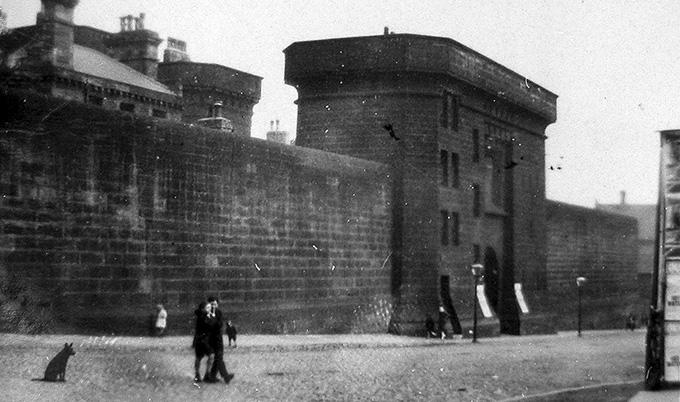Newcastle gaol
Research reveals the ghosts of Newcastle gaol
Published on: 10 May 2021
The fascinating stories behind the inmates of Newcastle’s Victorian prison are being brought together for the first time thanks to research by historians at Newcastle University.
The new ‘Newcastle gaol’ website reveals the grisly details of the conditions inmates were kept in, the crimes they were being punished for and what everyday life was like inside the gaol. It also contains archive photos of many of those who were detained, including children as young as seven.
Funded by the Catherine Cookson Foundation, the website is based on research carried out by Dr Shane McCorristine, from Newcastle University’s School of History, Classics and Archaeology with Dr Patrick Low, a graduate of Sunderland University and Megan Adams, a former history student at Newcastle University.
The website is the first phase in a long-term project to gather together research, ideas, memories, images and other content that can help tell stories about the gaol, the area around Carliol Square where it was located, crime and punishment in Newcastle, and more broadly, the East Pilgrim Street area and its history.
Among the stories included on the website are those about a group of 12 suffragists who were serving sentences of up to a month for their role in what was to become known as the ‘Battle of Newcastle’. The ‘battle’ was a series of protests to coincide with the visit of the Chancellor, David Lloyd George, to the Palace Theatre in Haymarket, Newcastle, in October 1909.
Their imprisonment attracted much public support, and crowds gathered outside the gaol to sing and shout their encouragement. One of the women imprisoned was Kitty Marion, a former actress and music hall star. As soon as she was led into her cell, Kitty barricaded herself in with the bedstead and refused to let any of the guards in. She later found a way to set fire to her bedding, causing pandemonium throughout the prison. She also immediately began a hunger strike, and in letters she sent to The Times, described the horrors of being force fed during her month-long sentence.
Another of the suffragists was Lady Constance Lytton, but because of her social status, the court offered the equivalent of a paying a fine as an alternative to going to prison. She refused this, and pleading guilty to the charges against her shouted across the court: “My disorderly behaviour of throwing a stone with violence in a public space was deliberate and intentional”.
Lytton also started a hunger strike but to her surprise, was never force-fed despite it being Home Office guidance at the time. She was released early and promptly began campaigning to make the public aware of the “partiality and injustice” of force-feeding women of lower social status in prisons.
Dr Shane McCorristine said: “The story of the gaol and those who were imprisoned there in many ways reflects the changing story of Newcastle. The area between Manors and Pilgrim Street, where Carliol Square is, was once the main route between the city and the quayside, but soon after the gaol was demolished in 1925, the whole area began to be transformed. There few signs of the gaol’s existence visible today, so the website provides a way to remember a bygone piece of the city’s history.”
As part of the project, the researchers reached out to the public to gather any memories or information about the prison and visitors to the website can read these, including the story of the discovery of a mystery body during the prison’s demolition.
Dr McCorristine added: “We had a great response to our request for the public’s help, with people sending us a range of stories about the prison and those who worked there or were detained there – including some rare letters written by some of the prisoners themselves, which give a great insight to their thoughts and feelings about being in gaol.”
Also on the website are details of some of the daring escapes made by prisoners, including 27 year old Mary O’Neil, who had been arrested in 1870 for stealing a purse on Clayton Street. Within a few weeks of starting her sentence, she had managed to remove the iron bars from the window in her cell and climb up on to the roof before disappearing over the imposing, 25 foot high boundary walls. She evaded capture for six months before being caught in Liverpool when a policeman recognised her from a photograph.
The gaol was designed by John Dobson and replaced Newgate, Newcastle’s medieval prison. Opened in 1828, it was among the first prisons to use a radial ‘panopticon’-style system, seen as a modern and progressive design that would help reform rather than punish offenders.
However, only five of the six radial wings were ever built due to high construction costs, and the number of inmates quickly increased due to the population growth Newcastle was experiencing at the time and an increase urban and poverty-related crime. Within ten years of the gaol opening, it was condemned for being damp and overcrowded, and there had been numerous escapes. Frequent violence among prisoners was also a problem in these early decades. Eventually, in 1858, Dobson was asked by the council to pull down the wings and replace them with a single four-storey block of 144 cells.
Dr McCorristine will explore some of the stories of the Gaol and its inmates in a free online talk on Tuesday 11 May, hosted by the Lit & Phil, Newcastle. To register to attend, and for more information, visit www.litandphil.org.uk/events/
The Newcastle Gaol website can be visited at www.newcastlegaol.co.uk




